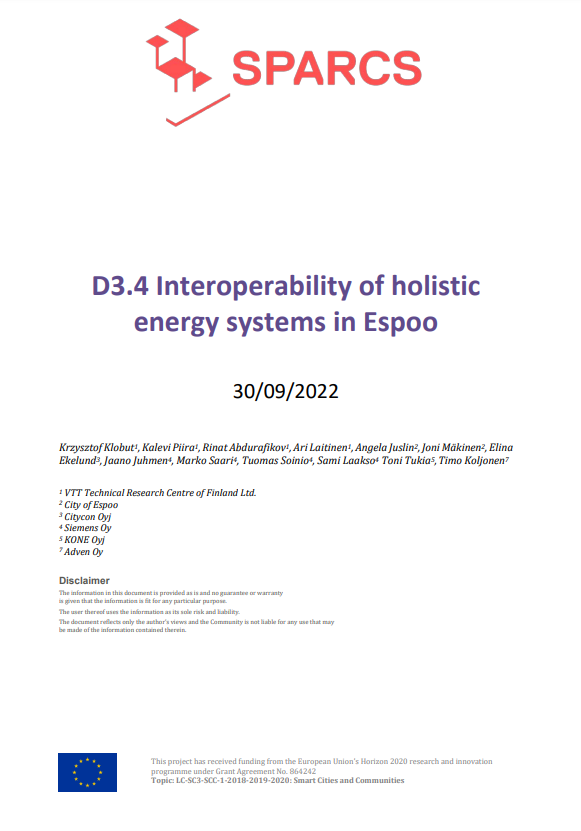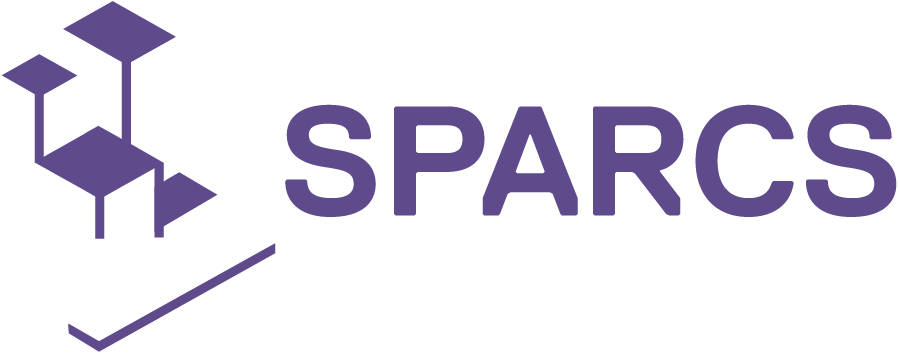D3.4 Interoperability of holistic energy systems in Espoo
This report addresses from energy point of view all of the demonstration actions that are realised by SPARCS in the city of Espoo, Finland by the end of the third project year. At beginning, an overall summary of the Lighthouse demonstrations in Espoo is presented,and then continue summarising the details in the demonstration areas. The demonstration actions cover broadly various low carbon improvements of urban area development, including buildings, energy systems, transportation, urban planning and citizen involvement. Some of these aspects are covered in other parallel deliverables,e.g. D3.3, however from another perspective.
Espoo city structure has five large district centres, and our demonstration areas focus on two of these centres in Leppävaara and Espoonlahti districts. Sello area at the centre of Leppävaara district is an existing urban area, where demonstration actions focus on improving (already high) energy efficiency of the existing urban infrastructure,although there are currently massive construction sites improving the public transportation connection. Lippulaiva block at the centre of Espoonlahti district is a new block that is currently under construction, hence, offering us a potential to test and demonstrate energy positive block solutions in new buildings. The most important part of it, Lippulaiva commercial center, has been completed and started commercial operations in March 31, 2022. In addition to more practical demonstrations, we have a 3rd demo site concentrating on urban planning in the Kera area, with the high ambition level for sustainable and smart district development. And finally, SPARCS also studies macro level demonstration actions in the city of Espoo.
This report describes the results obtained so far from the energy point of view and provides the summary of the progress towards the following monitoring phase.
Demo Lippulaiva
The construction of the new Lippulaiva shopping center has been completed and the mall operates since March 31st, 2022. Its heating and cooling demand is mainly covered with an on-site geothermal heat pump system (among the largest of this kind in Europe). Electricity demand is covered with PV panels (roof and façade) and certified renewable electricity. The energy consumption and production are smartly controlled and Lippulaiva participates in the Nordpool’s reserve market. The idea is to follow a day-ahead market price for electricity and participate in reserve market with battery storage. Simultaneously, the smart electricity control service should cut peak loads and gain savings in electricity costs.
Demo Sello
Smart energy solutions for self-sufficiency in the Leppävaara Sello center are in the focus. Sello’s thermal energy processes are modelled to understand the potential increased energy efficiency, self-sufficiency, and thermal flexibility. The potential is realized by providing the thermal flexibility to local district heating company (Fortum). Increasing the self-sufficiency through deep heat geothermal well is evaluated using the Power System Simulator PSS.The goal of the activities was to create a messaging interface between the Siemens building management system (BMS) and Fortum heat plant automation, send the required flexibility calls via the new interface and adjust the heating demand based on the calls. The solution is now implemented as a pilot project in the Shopping centre Sello. The created solution includes flexibility forecast and the actual demand response request sent by Fortum. The required actions are made by Siemens BMS, which adjusts the required flexibility based on the consumption at the time.
City planning
City planning for positive energy blocks is about the development and the planning of positive energy blocks. Mainly the focus was on exploring the possibilities to utilize tools (such as the Espoo’s 3D city model) in the development and the planning of new areas, but also on how to find energy infrastructure solutions and develop guidelines that enhance the uptake of such solutions.
The City of Espoo also examined different opportunities offered by energy community legislation and new cost-efficient renewable energy generation and distribution technologies. The work gives an overview of the existing regulations on energy communities and addresses the potential to form an energy community in the developing Kera district. Also assessed were possible business models for the electricity, heating, cooling and fuel sectors in the context of the Kera district. Current and new business models were mapped, and the suitability of different models to the Kera area was explained.
Smart and sustainable district heating holds great potential to reduce emissions.Artificial intelligence- driven district heating together with demand side management (DSM) play and important role in the climate challenge and help shaving thermal peak loads and save emissions. The conducted study on a sample of buildings provided quantification of energy savings and avoided emissions.
ICT demonstrations
Virtual Power Plants are a critical element in transition towards decentralized energy systems and are enabled by digitalization. The energy sector is expected to benefit from blockchain technology. Objective of one of the activities in SPARCS is to enable sector coupling and increase the interoperability, monitoring and control of various energy systems by ICT between smart buildings, smart grid and district heating and cooling systems, EV charging infrastructure, and the allocation of open data.
Models for building automation data were researched in Sello commercial center to allow creating more intelligent, scalable, and interoperable programs. The first architecture BIM model was done from drawings of building, later a 3D laser scanned point cloud was created from selected technical rooms in Sello. The point cloud was then connected to the Architecture BIM Model.
In-depth data analysis was done for Electricity, Water and Heating meters. The three targets “flexibility down”, “flexibility up” and “instant power reference” are now forecasted with a prediction horizon of 24 hours. These forecasts can be used as part of Sello’s energy optimization or in virtual power plant (VPP). The newly created Virtual Twin for Sello makes it possible to visualize selected energy or heating, ventilation, and air conditioning (HVAC) near real-time or historic data by 3D building information model (BIM) based virtual model. This helps to find and visually locate those Sello’s heating, cooling and air conditioning zones that are not working as energy efficiently as some other Sello zones.
Smart energy services
Activities about Smart Building Energy Management demonstrated how domain knowledge and real-time monitoring of elevators, escalators and people flow can be employed for smarter decision making and demand response actions by the building energy management system. KONE has developed an algorithm that can forecast the short-term, high-resolution power demand of selected elevators. In Sello, the communication between the KONE solution and Siemens platform was established, after which an air-handling unit was set to be controlled based on an algorithm interpreting the received elevator power demand forecast.
PED planning
This work aimed to clarify how CityGML could support low carbon urban planning and block/district level energy analysis. To carry out block-level 12-month simulation, a simplified building energy consumption model implemented in Apros software was adapted as python scripts to be run from QGIS python console to visualize the results on map. With this approach the building models can be used to estimate the aggregated impact of energy efficiency improvement measures, e.g. replacement of energy efficient windows or rooftop PV installations in the building stock in the city. A visualization of results in terms of the indicators for electricity was implemented for buildings using color-coding in QGIS software.
To create new approaches for smart city planning that could also take into consideration PEDs, the City of Espoo conducts a process to create a “co-creation model” for sustainable and smart urban areas. Developing such a smart city area as a whole required new tools, practices and processes of co-creation and dialogue to connect the different stakeholders, builders, investors, policy makers, organizations and citizens together in the city planning. This process covers the whole life cycle of the area from the initial planning to the in-depth design, construction, and use and operation phases.

